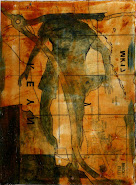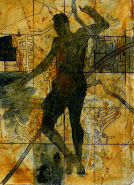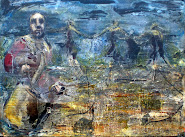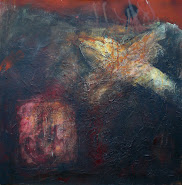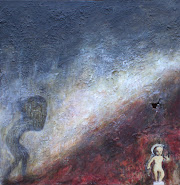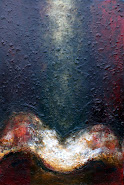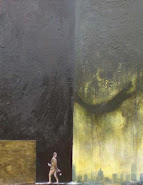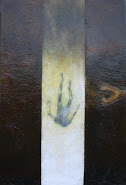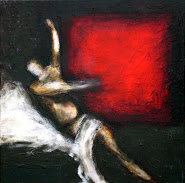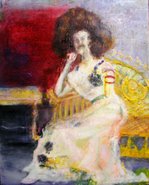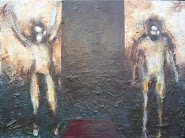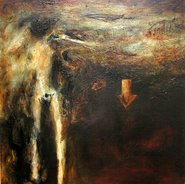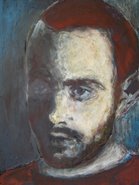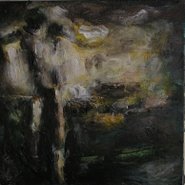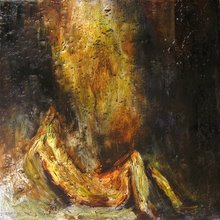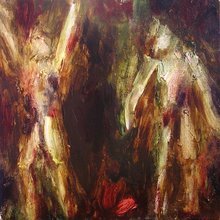
Without wishing to repeat myself I wanted to consider my intentions in the continuing Danae series. I have been working on designs explicitly based on Titian’s Danae paintings for a year now. In the last month they have translated form digital designs to painted form. One is complete and another is on its way. I thought it worth trying to articulate my aims with this particular ‘crop’ of work.
I am interested in both the pose and the subject matter of Titian’s work. As is often the case he drew his inspiration from an Ovidian source. The story of Danae appeals to my sensibilities as it is one of love, sex and ultimately death, the key ingredients of human tragedy. The Greek myth stats that Danae’s father (King Acrisius of Argos) was keen for a male heir. The tragic seed is planted by his inquisition of an oracle who confirmed he would have a grandson but that his grandson would kill him. (Proto King Lear in the kind of tragedy) In order to stop this happening he looked Danae up in a bronze tower.
Whilst in the tower Zeus took a fancy to Danae. He transmuted into a golden shower and entered through the window, thus impregnating her. This is the scene which Titian and Rembrandt showed and is the scene I am interested in. The moment in which form melts into light, the coming together of two realms- almost a metaphor for the experience of creating and viewing a painting. A painter is only given one moment and as the dramatic crux of the story this is the moment to select. This does not mean, however, that reference cannot be given to the scenes wider narrative context.
In Titian’s painting (Particularly the versions with the old nurse rather than Cupid) there is a definite dark foreboding air beneath the scene of celestial lust. It is this which I want to borrow and exaggerate. I want a moment of conception which is as sensuous as it is dark. Whilst I have borrowed explicitly from Titians figure I have looked to push other things in another direction. In my first effort I worked out the composition in a square format. I thought this would give the image more the feeling of a dramatic statement than a view into a boxed, voyeuristic stage.
 It is my later (currently unfinished) work which I am happier with in construction. The format has moved from Titian horizontal rectangle to a vertical one. I hope this exaggerates the downward motion from the light above to the form below. I believe the space and shape of a canvas can be used to create a visual dynamic. Danae’s position in the bottom half of a taller rectangle should provide the means to dramatise the lustful moment.
It is my later (currently unfinished) work which I am happier with in construction. The format has moved from Titian horizontal rectangle to a vertical one. I hope this exaggerates the downward motion from the light above to the form below. I believe the space and shape of a canvas can be used to create a visual dynamic. Danae’s position in the bottom half of a taller rectangle should provide the means to dramatise the lustful moment. Beyond this I wanted a sense of the sinister. The notion that the moment of lust ensures the inevitable death of her father is something which fascinates me. It is as if some unseen force of nature is at work. Call it fate, divine intervention, the zeitgeist or whatever you want. For me this is what the crow can symbolise. I think it is similar to the Crow’s symbol in Ted Hughes’s poem. As some creature which governs all humanity, whose every action has some chaos theory ramification. I see the crow as a post god controller of humanity, capable of flying through space and time. For me he is the protagonist of tragedy. Is he the antithesis of Cupid or perhaps Cupid himself in his true form, the planter of tragic seeds?
My desire is to have a sense of the crow in the painting. Not a graphic reference but a sense of otherness, a sense of a mystical form which occupies or passes through the space, which appears to be the conductor to the paused theatre. I like the idea that he kicks of a succession of events then leaves and lets havoc break lose. The notion of being disguised as Cupid is due to a belief that the succession of events he causes are ultimately tragic in that they start of with happiness of love but have an inevitability of death and depression in them.
The Crow is therefore a reference to the sense of Shakespearian tragedy I want in this painting. Firstly the right hand side of the painting has a curtain. Obviously not at all original but it gives the feeling of a stage, as well as framing one edge of the painting. This creates a stage like feel, we become the spectator and what’s more it creates a closed door on one side of the painting which suggests the other is open. I have placed him centre right. He is moving from right to left, as if exiting the stage. It is if he has some, planted the narrative seed, then left. (With only one moment, and the inability to show successive events, I believe this is very much the painter’s role, to plant the narrative seed then leave. So in this sense the crow becomes self reflexive with the painter being the unseen force, the demi god of his own worlds; self loving or what?!?!) I believe that placing the crow central with a horizontal dynamic creates a dichotomy between the central act and this supporting role. The verticality of the divine union is countered by the horizontality of the protagonist’s action and exit. A play on such spatial concerns is of course time old. Just think of the cross, the horizontal being the earth and the vertical being the move through the earth from a profane to sacred realm. The physiological tension of such dynamics only works by having one play off against the other. What is created is a dialogue between the two in which meaning can be found. In this case the vertical is the moment of lust, the moment of conception. The horizontal is both the cause and the effect. The crow as the protagonist which flutters and pulls the curtain back to start the chain of events and the knowing being which moves through time to ensure the act concludes with the fulfilment of the fatal premonition.

.jpg)








